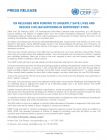(New York, 06 February 2020): UN Humanitarian Chief Mark Lowcock today announced, at a UN Security Council meeting, the release of US$30 million from the Central Emergency Response Fund (CERF) to immediately scale-up shelter and other critical assistance to thousands of civilians bearing the brunt of the unfolding humanitarian catastrophe in northwest Syria.
Air strikes and shelling have forced an estimated 586,000 people, mostly women and children, to move in the attempt to find safety. Some 200,000 people moved in the 8 days between 26 January and 2 February. An additional 280,000 people from urban centres in the region, face an imminent risk of displacement if military operations continue.
“We have seen chaotic pictures in town after town as vehicles line up in every direction trying to flee. People who have just moved cannot find adequate shelter. Tens of thousands are crammed into schools, mosques and unfinished buildings. Many are in tents in the mud, exposed to wind, rain and freezing weather,” said Emergency Relief Coordinator, Mark Lowcock.
The CERF funds will help to provide shelter and other essential relief items in the harsh winter.
UN and humanitarian partners are doing everything possible to address the significant needs of some 3 million people in north-west Syria. In January, 1,227 trucks filled with humanitarian aid were sent through Bab alHawa and Bab al-Salam border crossings. Some 900 trucks carried food assistance for 1.4 million people.
Others carried health supplies for about half a million people, and other relief items for over 230,000 people. “This is the most aid the UN has sent across the border in any month since the operation was authorized in 2014,” said Mr. Lowcock.
This week, the humanitarian community released a $336 million Humanitarian Readiness and Response Plan for northwest Syria to address the needs of up to 800,000 people over a six-month period. The CERF allocation will help kick start the plan.
Despite immense efforts by humanitarian organisations, needs are growing exponentially in northwest Syria.
How severe the crisis becomes will depend on whether a solution can be found to ease the situation for those still in harm’s way and those crammed into an ever-smaller area in the northwest of Idlib. “A ceasefire would be a first step, as would the implementation of obligations under international humanitarian law to protect civilians and civilian infrastructure,” said Mr. Lowcock.
This $30 million for Syria is in addition to the $44 million allocated in December in response to the Syria crisis, which also covered the needs of Syrian refugees in Jordan and Lebanon.
CERF funds kick-start or reinforce emergency lifesaving response across the world. Since its inception in 2006, CERF has assisted hundreds of millions of people by providing more than $6 billion to over 100 countries and territories thanks to generous and consistent donor support.
For further information, please contact:
In New York, Zoe Paxton, zoe.paxton@un.org, + 1 917 297 1542
In Geneva, Jens Laerke, laerke@un.org, +41 79 472 9750



